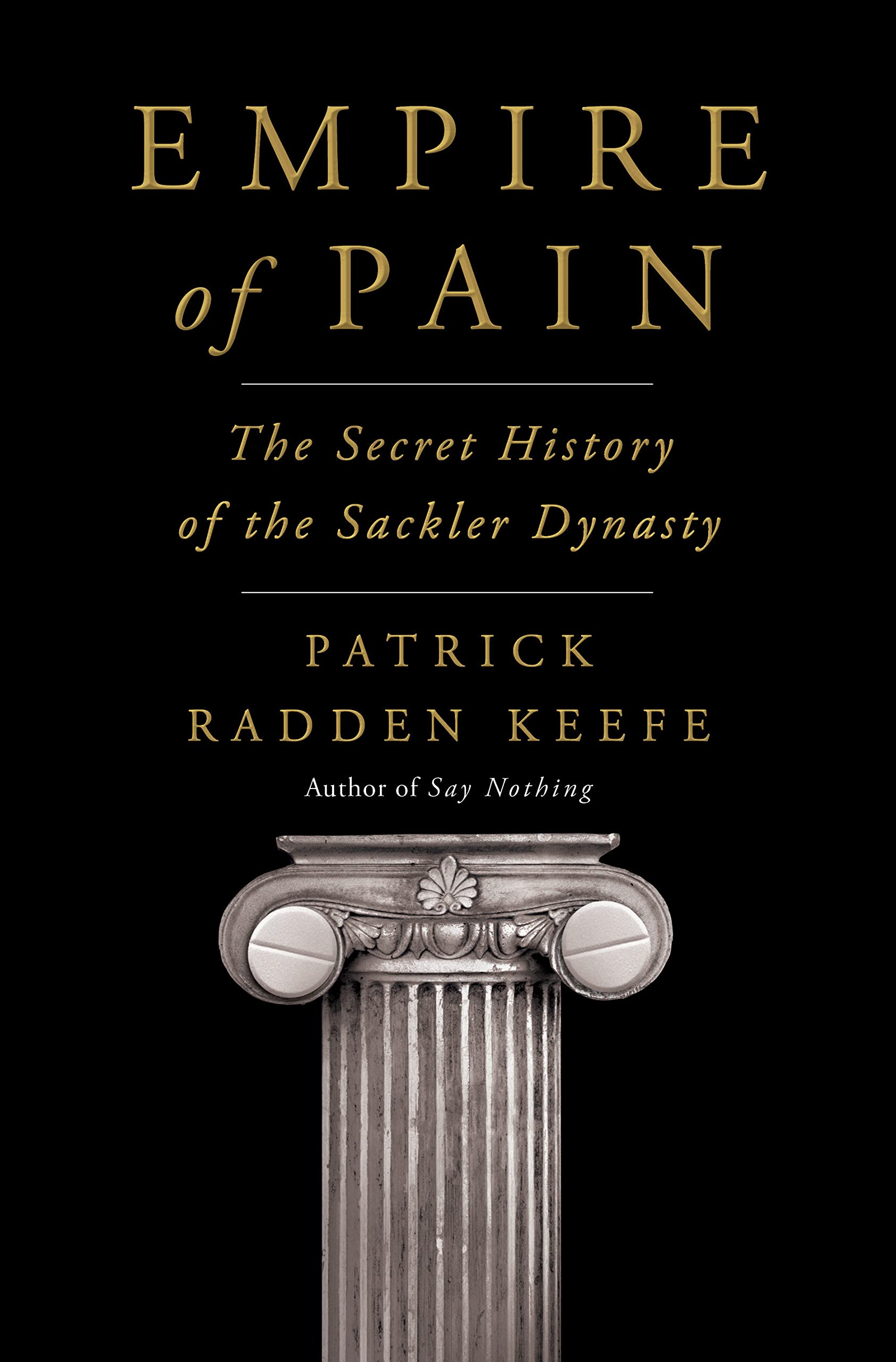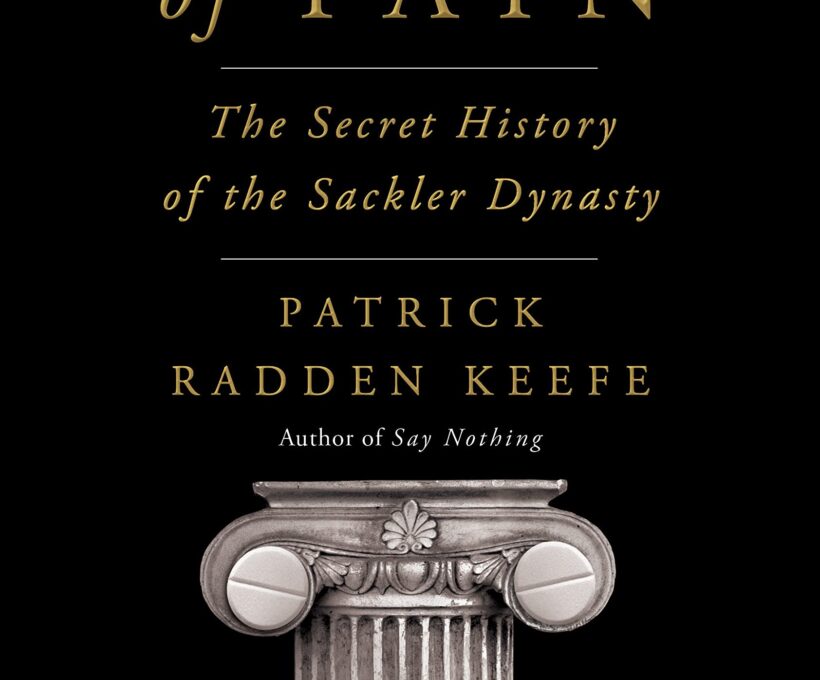Patrick Radden Keefe
New York
Doubleday
2021
535 pages
According to the Art:
Patrick Radden Keefe goes deep into how and why the Sackler family and its company, Purdue Pharma, fueled the epidemic with its product OxyContin.
Synopsis:
The opioid crisis, now nearing the end of its third decade and still raging, is generating its own literature. Entries into this literature at this stage must dig into the more detailed aspects of the epidemic if they are to unearth any new information or insights. Patrick Radden Keefe, in his book, Empire of Pain, goes deep into how and why the Sackler family and its company, Purdue Pharma, fueled the epidemic with its product OxyContin.
By the time Keefe begins writing this book a lot is already known about the Sacklers, from his own reporting and the reporting of many others. His stated intention thus became,
to tell a different kind of story…a saga about three generations of a family dynasty and the ways in which it changed the world, a story about ambition, philanthropy, crime and impunity, the corruption of institutions, power, and greed.
p. 437
He goes on further in specifying that the story of the Sackler family is not the whole story of the opioid crisis.
My choice to focus on Purdue is in no way a suggestion that other pharmaceutical companies do not deserve a great deal of blame for the crisis. The same could be said for the FDA, the doctors who wrote prescriptions, the wholesalers that distributed the opioids, and the pharmacies that filled the prescriptions…I do share the view, however, of many doctors, public officials, prosecutors, and scholars that Purdue played a special role, as a pioneer.
p. 438
Keefe starts his story with the arrival in the U.S. of the family patriarch, Isaac Sackler, in 1904. Isaac’s story is the classic and romantic tale of the immigrant who works hard and, by turns, succeeds and fails in his own small businesses. He and his wife, Sofie, who is also an immigrant, pushed their three sons hard to become physicians because they considered Medicine a “noble profession” and doctors as “morally upright.” (p. 17) While they lamented their finances could not support medical school for any of them, they told them they were blessed with a “good name,” and warned that “if you lose a fortune, you can always earn another, but if you lose your good name, you can never recover it.” (p. 434) Keefe’s investigation reveals just how that happened.
The family trajectory is knit together across three sections roughly corresponding to the three generations Keefe covers. He provides a thorough investigation into the family history, personal behaviors, business decisions, and philanthropic activities relevant to the family’s role in the opioid crisis, its exit from Purdue Pharma, and eventual public humiliation. Always tethered to the story is the carnage and death the opioid crisis has wrought on individuals, families, and the public.
Other sources are required for a wider view of factors driving the opioid epidemic. Indeed, the choice of sources are less a matter of which to read than a matter of which to read first.
Analysis:
Keefe’s investigation into the Sackler family offers reasons why the role of OxyContin in the opioid epidemic could not be stopped, however exasperating and destructive it became. A more haunting question raised is why couldn’t the OxyContin-fueled opioid crisis been seen coming based on how the Sacklers operated before they formed Purdue Pharma. The tactics the Sacklers deployed in driving OxyContin use had been honed during the preceding decades with other drugs of other companies.
All three of Isaac and Sofie’s sons followed their parents’ urging and graduated from medical school. All three then became psychiatrists. After having been horrified while witnessing ice pick lobotomies at an asylum, the oldest brother, Arthur, became interested in finding drug therapies for mental illnesses. Though he began this quest in research, his experience working in high school, college, and medical school writing ads eventually led him into the advertising industry with the William Douglas McAdams agency, a company specializing in “ethical pharmaceuticals.” He would become the president and owner of the company, where he would bring to its pharmaceutical company clients the type of advertising more often associated with consumer products.
Arthur, with his two brothers, eventually added a small pharmaceutical company, Purdue Frederick, and then over the years acquired other businesses and established strategic relationships giving them more control—tentacles—over the prescription drug life cycle.
They could develop a drug, have it clinically tested, secure favorable reports from the doctors and hospitals with which they had connections, devise an advertising campaign in their agency, publish the clinical articles and advertisements in their own medical journals, and use their public relations muscle to place articles in newspapers and magazines.
p. 89
The Sacklers gained more control yet through coopting certain individuals within federal regulatory agencies (e.g., U.S. Food and Drug Administration), “wining and dining” prescribers, and controlling a pharmaceutical data company (IMS) that profiled prescription patterns of individual physicians for the purpose of generating high-yield sales leads. These and other practices had been well rehearsed—most notably with chlordiazepoxide (Librium) and diazepam (Valium)—and constituted the playbook the second-generation Sacklers would apply to the sales and marketing of OxyContin.
Keefe’s investigation reiterates the sad realization other investigations reveal about how we cannot expect any moderation in aggressive pharmaceutical sales and marketing practices even when catastrophic consequences of dangerous overuse can result. Sadder still is that the forces working against responsible moderation are human traits, which in this case are ambition, power, greed, and denial, and together manifest in the Sackler family story as the four horsemen of the opioid apocalypse.
Also:
On this subject, I cover Beth Macy’s nonfiction book, Dopesick, and Danny Strong’s dramatization of it in the TV miniseries of the same name. I also cover Barbara Kingsolver’s literary novel centering on the opioid crisis in Appalachia, Demon Copperhead. A discussion of how these works compare with one another and how one may be preferred over the others or the order in which they should be approached is the subject of the episode, Getting Dopesick: Four Angles on the Opioid Crisis, on the podcast, The Clinic & The Person.
Ice pick lobotomy procedures and their use in the mid-1950s are portrayed in the movie, The Mountain, which I cover here.




